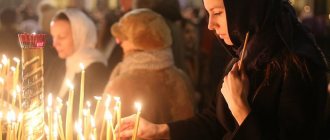How to dress as a woman
To be dressed appropriately, you need to know what to wear as a woman when visiting a holy place. In ancient times, they wore all their best clothes to the temple, because the church is not just a building, it is a temple!
There are 4 main rules in clothing that every lady must follow when planning to visit a holy place.
- Maintain morality. The temple is visited not only by women, but also by men. To prevent men from being distracted from prayer, women should not go to a holy place with their shoulders bare, wearing a low-cut blouse. This will be considered a sin. You cannot wear vulgar makeup, including lipstick. When you touch the icon, you can leave a lipstick mark on the glass, which other parishioners will not like.
- Is it possible to come in red? Save the red for another occasion. Having a red dress, you will find more than one reason to wear it. Choose clothes that are not too bright, not necessarily black, gray, or dull. This can be light clothes in non-provocative tones. The main condition is modest and elegant.
- What to do with trousers? A woman should not wear trousers to church. Today there are churches where they turn a blind eye to this, but still set a rule for yourself: trousers are for another occasion. If you are wearing trousers and need to visit a holy place, they may offer you a skirt to wear over your trousers. Then it must be put back in place.
- You must wear a scarf. Why is a scarf needed? This tradition has deep roots. The scarf emphasized the status of a married woman. In ancient Rus' it was considered a shame to see a married lady without a headdress. This is where the expression “goofing off” came to us. But today even little girls’ heads are covered, that ancient custom is so firmly established. In this case, the headscarf means modesty and chastity. In order not to see the condemning glances of parishioners on you, be sure to adhere to this tradition.
If the scarf does not match the suit, then you can go in wearing a beret or a hat with a beautiful veil, but your head must be covered.
Origin of the tradition
The tradition of women covering their heads in the temple has deep roots. In ancient times, in the cultures of many nations, covered hair was a sign that determined the status of a married woman, indicating her subordination to her husband. It was forbidden to appear on the streets with your head uncovered; it was considered very immodest.
Woman in the temple
Similar “dress code” rules existed in Jewish culture, where Christianity was born, and in Roman culture, where the first churches appeared. This is due to the fact that in the Epistles of the Apostle Paul the following words are written:
"5. And every woman who prays or prophesies with her head uncovered disgraces her head, for it is as if she had been shaved.6. For if the wife does not want to cover herself, then let her cut her hair; and if a wife is ashamed to be shorn or shaved, let her cover herself.” (1st sequence to Corinth.)
Someone may wonder: if in those days the wearing of a veil by married women was a universal rule, why did the Christians of the Corinthian church violate it, since the Apostle Paul had to specifically write about it? There is a version that this was due to the particular depravity of morals in the pagan city of Corinth (it was famous for this).
Because of this, local residents considered it unnecessary to observe the then widespread rules of decent clothing. And Christians, since they grew up in this city and were accustomed to its atmosphere, could also be infected with something from the general debauchery. Therefore , the Apostle Paul called on Corinthian Christian women to be extremely modest and chaste in clothing, to comply with all the rules of decency that existed in those days.
In ancient Rus', the custom of women covering their heads after marriage was also in use. According to the ideas of our ancestors, if strangers see a woman without a headscarf, it will be a shame for her and her entire family. This is where the expression “goofing off” comes from.
In the church this custom has been preserved to this day, but has changed.
If previously the tradition of covering their heads concerned exclusively married women, and girls did not wear headscarves either in church or on the street, now even little girls’ heads are covered.
Customs associated with the headscarf
What kind of scarf should I wear to church? It can be any color except black. Black is a sign of mourning. It is worn when mourning for the deceased. A long time ago in Rus' they followed this custom: to wear scarves of the color that corresponded to the colors of the church calendar to services:
- For Easter it was red or white and was worn for all 40 days of the holiday.
- A white handkerchief was prepared for Christmas.
- For Lent, dark blue and purple colors were chosen.
- On the Feast of the Life-Giving Trinity and on the Day of the Holy Spirit, green was worn, signifying the color of life.
- On other Mother of God holidays, they wore a headdress the color of the sky.
- Yellow scarves were worn for regular services.
It is believed that a man is closer to God, so a man can stand in the service without a head covering. a headdress is mandatory for her .
If you find out exactly where the custom came from - a woman to have her head covered, but a man not, then it is worth remembering the words of the Apostle Paul, who said that a headscarf on a woman’s head meant her submission to her husband and his power over her.
Previously, married women even wore a headscarf on the street. If a husband sees his wife without a headdress, then the matter could lead to divorce. With this behavior she disgraced him in front of people. Only harlots walked around bare-haired.
Modern hat etiquette
Today, many countries no longer adhere to this rule. You can easily see representatives of the stronger sex with their heads covered in a library or museum. This is no longer considered an indicator of politeness.
But in fact, this tradition was not canceled and the rules of modern etiquette say that men are recommended to take off their hat :
- When the national anthem is played and the flag is raised;
- In the church. Many people do not know the rationale behind this rule of conduct in church. It is believed that in this way a person shows admiration for God. He seems to say: “We are all equal, we walk in peace and repent of our sins”;
- At official events;
- When meeting and talking with a woman. Wearing a hat with her is considered ignorance;
- At catering establishments: in a restaurant, cafe or bar. But there is an interesting point here: this rule does not work in fast food establishments;
- In cultural institutions: museums, theaters, exhibitions and galleries.
Hat traditions, of course, are slowly dying. In the modern world, less and less time is spent on etiquette. But his knowledge sharply distinguishes a person from the rest and even slightly elevates him in the eyes of others, inspiring respect.
How to dress for church as a woman
We have looked at the basic rules , now we will go into detail: what a woman can wear to church.
We found out that you are not allowed to go to church without a headscarf. Is it possible to walk in sandals? Sandals are possible, but the heels must be closed, that is, the woman must wear socks, knee socks or tights. It is not recommended to walk without tights or other things covering your bare heels. It is indecent to come to the temple with bare legs.
What dress? The dress should be modest, without slits, below the knee, or even better - maxi. The dress should not be completely sleeveless or short sleeved, preferably with three-quarter or long sleeves so that the arms are covered.
What kind of skirt should you wear to church? The skirt should be below the knee or maxi. Doesn't have to be black. The skirt can be straight, but not tight, but preferably flared, not transparent, without rhinestones and unclear inscriptions.
What shoes to wear to service? Closed shoes or low-heeled sandals are suitable. It will be difficult to stand in heels for the entire service. You should not come to church in sneakers and a tracksuit. You will have the opportunity to dress in sportswear.
Orthodox Life
KDAiS teacher Associate Professor Sergei Bortnik is against the unisex style of clothing and probably knows where a woman’s place is.
– What is expected of a woman in the Church?
– Women, like men, are parishioners of the Orthodox Church. These are baptized people. And the Sacrament of Baptism presupposes awareness of one’s faith and active participation in parish life, in particular in the Eucharistic service. This is the most important thing in the life of any person, including women.
– From the point of view of modern secular culture, there is discrimination against women by the Church: they are not allowed into the altar, it is mandatory to cover their heads in church, unlike men, women cannot be priests... Why is this happening? - This is a wrong opinion. Of the above, the only undeniable fact is that a woman cannot be a priest, because a priest is an image of Christ. Christ was a man, so it is believed that a woman cannot carry out this ministry. It should be perceived not as a right, but as a Cross - service for the good of people and the Church. Some theologians point out the advisability of not burdening women with the heavy cross of priestly service.
It happened that I myself was not allowed into the altar of some temple or cathedral, thinking that I was not involved in Christianity, in Orthodoxy. These warnings apply to both women and men. And if we talk about a scarf, then it’s better to wear one than without a hat. Sometimes, when worship takes place in an unheated church in winter, men have to freeze without a hat. And women can wear both a hat and a scarf.
If we talk about certain discrimination in our Church, then by and large it concerns not so much women as the laity in general. For example, sometimes there is a certain clericalization of the church community, when a priest clearly has more rights than a layman.
– Why is the place of women in the temple on the left side?
– Different Local Churches have their own practices. In Romania, for example, men stand in front and women stand behind. In my opinion, it doesn’t matter where women are – on the left or on the right. The main thing is for both men and women to be as focused as possible on prayer. It is for the sake of concentration, and not to be distracted by extraneous things, that it is customary to separate them.
How to dress for a man's service
Men who attend church also have their own requirements. Firstly, you cannot come to the temple wearing a headdress.
How should a man dress? The most appropriate clothing is trousers and a long-sleeved shirt. Bermudas and capri pants should be excluded; it is indecent to come in shorts. If you are wearing a T-shirt, then it is better to wear a jacket or jumper on top.
What about jeans? Many young people don't have trousers at all. It is not forbidden to enter church in jeans. In the summer, wear closed-toed shoes to church, but not flip-flops or flip-flops, to avoid showing off your bare ankles during the service. This is not even a canon, but a requirement of good manners.
Dear friends, despite changes in fashion, church rules should be respected and observed . Knowing how to dress for church will help you choose the right clothes for visiting a holy place.
When can a man keep his hat on?
Of course, you don’t have to bare your head on every occasion. There are situations where this is inappropriate:
- At events held on the street;
- In the elevator, if there is no lady nearby;
- In public buildings: hotel, airport, etc.;
Also remember some subtleties of etiquette. If you are next to a girl on the street, you don’t need to freeze out of a desire to seem polite. In this case, it is quite acceptable to hide your head from the wind or rain.
There are also personal reasons why you cannot get rid of your headdress when meeting a lady. Then don't do it. Simply lift it up or touch it with a slight nod of your head. In this case, your respect will be indicated and you don’t have to take off your hat.
And yet the tradition lives on. It is rare to see a young man wearing a hat in church or in the cafeteria. And if you see him, he will definitely be reprimanded. And this is good. Traditions must be observed and protected, especially if they are designed to make people polite.
And it is politeness that this rule teaches. It obliges you to show respect to others. That's why you can't wear a hat in a building - it's rude to others.
Women's clothing
Indeed, in Deuteronomy, where Moses gives the Israelites the laws by which they should continue to live, it is written: “A woman must not wear a man’s clothing, and a man must not put on a woman’s clothing, for anyone who does these things is an abomination to the Lord your God” (Deut. 22:5).
The famous interpreter of Old Testament texts, theologian and writer Alexander Lopukhin points out: the goal of Moses and God, who speaks through his mouth, is to preserve the Jewish people from unnatural corruption, that is, from homosexuality, which was common among many pagan peoples of the world. The Bible indicates that this is unacceptable: “You shall not lie with a man as with a woman: it is an abomination” (Leviticus 18:22). There is a version that cross-dressing was also associated with various pagan rituals, when, when praising demons, priests changed into clothes of the opposite sex.
On the other hand, neither in the times of the Old Testament nor in the times of the New Testament did they know about trousers, and even more so, about women’s trousers: both sexes wore mantles of different lengths. Women's mantles were most likely longer and made of soft and thin materials.
The decision of the Sixth Ecumenical Council, which was convened in Constantinople (Constantinople) in the 7th century, is in complete agreement with the Old Testament. On it, the exarchs of the church determined that: “no husband should dress in women’s clothing, nor any wife in clothing characteristic of a husband... ...nor wear comic disguises... ...not proclaim the vile name of Dionysus...”. Here we are also talking, first of all, about same-sex relationships and rituals of worship of pagan gods.
What scarf should you not wear?
Easter is a great holiday for all Christians. On this day, women dressed in their most elegant dresses and scarves. Moreover, each festive event was marked with a special color of the headdress.
There is even a certain reminder, following which a girl will not make a mistake with her choice of color.
A reminder for choosing the shade of a headdress for women
To put aside an accessory that should not be worn on Easter Sunday, we offer a detailed reminder.
- White. Snow-white linen is worn only on the occasion of great Christian holidays; Easter is one of these.
- Red. Will be needed for all subsequent Easter services.
- Yellow. Worn for ordinary Sunday services.
- Green. Mainly used for services on Palm Sunday and Trinity.
- Blue. Suitable for worship on the feasts of the Blessed Virgin Mary.
- Violet. To commemorate the Life-giving Cross of the Lord.
- Black. On days of mourning and during Lent.
- Burgundy and scarlet. On Maundy Thursday.
- With print, floral. Designed for “dirty work” for women helping in the temple.
Important! For women who do not regularly attend all services in the temple, two types of headdress will be sufficient. Light colors are suitable for all festive church events, and dark colors are suitable for days of fasting and mourning.
Even if a woman wears a black headscarf to a service on the occasion of the holiday, no one will kick her out of the temple. But this will disrupt the overall picture of the celebration and put the girl in a bad light. It is still better to take into account the color of the headdress in advance when choosing your outfit.
Headdresses of the Orthodox Church
And if women in church cover their heads and men bare their heads, the clergy are required to wear special headdresses.
The most common of them is skufja. It is a soft, pointed black hat whose folds form the sign of the cross. For married priests it is purple; for the patriarch and archbishop, a four-pointed cross is attached to its upper part.
Skufia is worn by monks and novices
An upwardly expanded but solid cylinder of different shades, purple, black or blue, is a kamilavka. It is a liturgical reward.
You can see the kamilavka on priests of the white clergy and on protodeacons
A hat resembling a royal crown is a miter. It is part of the vestments of such clergy as bishops and archimandrites.
Symbolizes the miter of thorns and the royal crown of Christ
Klobuk is a type of black kamilavka with a basting train divided into three parts. Monks wear it not only during worship, but also in everyday life. Archbishops have a crucifix embroidered on their train.
Metropolitans have a white hood decorated with a cross
There is a separate dress for female nuns in the church - this is the apostolic dress. It is a scarf with a cutout for the face, covering the head, part of the back and chest.
On top of the apostle, the woman puts on a skufia or kamilavka, depending on her rank
The Russian patriarch has a modified hood on his head - this is a kukol. It is a solid white cap with images of winged seraphim on the forehead and ends of the train. There is a cross attached to the crown.
The kukol is the everyday headdress of the Russian patriarch
Sometimes you can find an interesting outfit for a clergyman - this is a black embroidered robe with a hood and two long strips of material covering the back and chest. This outfit is called the schemanik's doll. Crosses, winged seraphim and the scripture of the Trisagion are depicted on it with white threads.
The schemanik's doll is put on over the mantle











